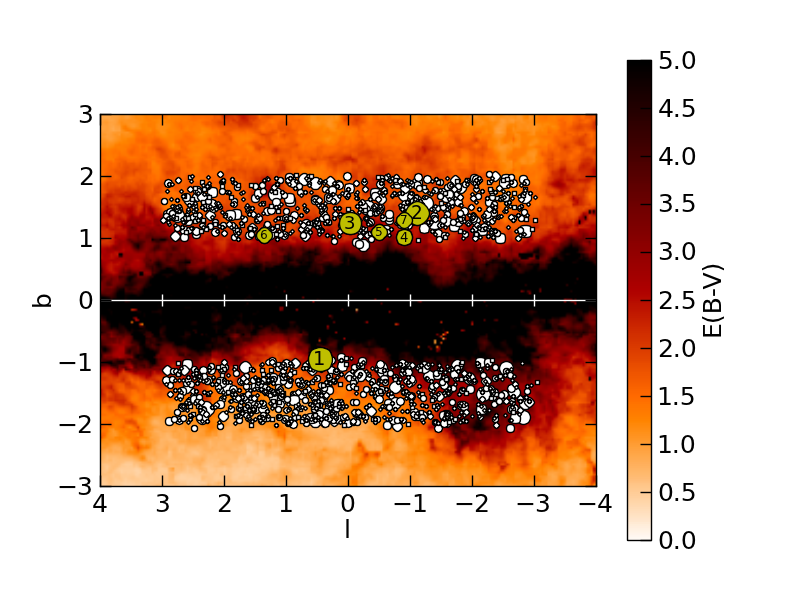Principal Investigator: Robert Hynes, Louisiana State University
Program Summary:
The Galactic Bulge Survey (GBS) is a Chandra flux-limited X-ray survey of faint X-ray sources towards the Galactic Bulge. Chandra has now completely imaged an area of 12 square degrees in two strips above and below the most extincted regions of the Galactic Plane (see Figure). Our survey is broad in area but shallow in order to maximize the numbers of moderately luminous sources, principally quiescent low-mass X-ray binaries (LMXBs), relatively to less luminous sources such as active stars. The Chandra observations have yielded 1640 unique sources and are complemented by many multiwavelength supporting observations including optical variability surveys, multi-object survey spectroscopy and UV imaging with Swift. It also overlaps with other key surveys such as VVV and OGLE. The Galactic Bulge Survey collaboration includes scientists from the Netherlands, United States, United Kingdom, Chile, and Canada.

Figure 8: GBS sources overlaid on the VVV extinction map. Circles indicate X-ray brightness and the seven brightest objects are numbered: CX1 is a transient LMXB in outburst, CX2 is a background active galaxy, CX3 is a low luminosity persistent LMXB, CX4 is an active K giant, CX5 is a magnetic CV, CX6 is a Be star, and CX7 is a pre-main sequence K star.
We expect the GBS sample to be dominated by i) quiescent LMXBs; ii) cataclysmic variables (CVs), and iii) active stars and binaries. Based on our best estimates of source populations from population synthesis models, typical source properties, and appropriate reddening for our fields, we expect about 300 LMXBs in the X-ray sample, of which half should have accessible optical counterparts. The large predicted number of LMXBs is a consequence of the predictions of population synthesis models that there must be many unseen quiescent systems. Only a fraction of these predicted Galactic LMXBs have been identified leaving the credibility of the population synthesis results in question. The only way to confirm the predictions is to search for the systems while they are in quiescence. This will provide the most robust estimate of the number of black hole binaries in the Galaxy, and test our understanding of binary evolution.
The X-ray selected sample of LMXBs and CVs can be used to measure masses of black holes and neutron stars, and white dwarfs respectively. Dynamical masses are often the only secure way to discriminate between these source classes, and can address multiple science questions in their own right including i) the true stellar mass black hole mass distribution; ii) the reality of the apparent mass-gap between neutron stars and black holes; iii) the maximum mass of neutron stars; and iv) the discrepancy between predicted and observed white dwarf mass distributions. Masses derived from GBS objects will have less selection effects, or at least different selection effects, to the currently known masses.
The GBS collaboration will use this Gemini-S Large and Long program to measure radial velocity curves for a sample of the LMXB and CV candidates discovered by the survey and classified based on photometric lightcurves and spectroscopic snapshots. We will discriminate between LMXBs and CVs, and measure masses for all of the selected objects. This will be the first systematic sample of dynamical masses obtained from an X-ray selected survey, and the LMXBs identified will be the first such objects found in quiescence outside of globular clusters.
Co-Investigators:
- Tom Maccarone, Texas Tech University
- Craig Heinke, University of Alberta
- Peter Jonker, SRON, Netherlands Institute for Space Research
- Danny Steeghs, University of Warwick
- Manuel Torres, European Southern Observatory
- Jianfeng Wu, Harvard-Smithsonian Center for Astrophysics
- Christopher Johnson, Louisiana State Unviersity
- Christopher Britt, Texas Tech University